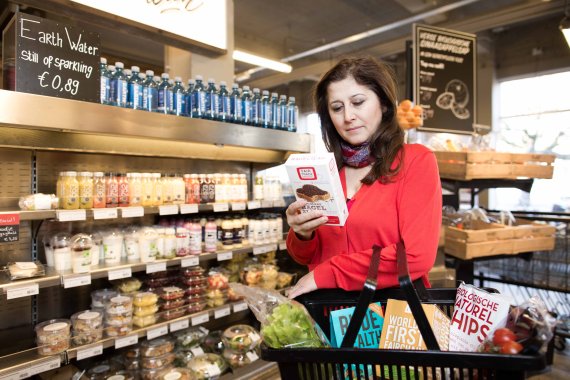Photo: Freek van den Bergh. D66 MP Fatma Koser Kaya wants to nkow whetehr information on food packaging about origin and health imacts really helps.
‘I understand Koşer Kaya’s question,’ responds Hans Dagevos. ‘State Secretary Martijn van Dam of Economic Affairs is aiming at more transparency in the food chain. One way of doing that is through apps on our mobile phones on which we can read where the food in the shop comes from.’
There are already various logos on food products. Are they effective?
Dagevos: ‘One prominent logo is the Ik Kies Bewust logo with its check sign. This has most effect on consumers who already think about health issues, but very little on less health-conscious consumers, such as many people from lower socio-economic classes.’
‘However good the logo on the packet, you don’t stand a chance against K3’
Ellen van Kleef: ‘In 2015 we published a scientific article on health logos, for which we looked at about 100 studies on whether consumers look at logos in supermarkets and shops, whether they understand them and whether they influence their behaviour. What emerged was that only a small proportion of consumers look at these logos. In the US a star system was introduced, but was found to have a limited effect on purchasing behaviour. There are only a few studies asking whether people’s eating habits are changed by the logo system. These studies find little or no effect. We ourselves did research in Spain, using a buffet offering food with and without nutritional logos. We didn’t find a significant effect there either.’
Dagevos: ‘With logos alone we are not going to succeed in changing behaviour. And that is only logical, to be honest. That kind of logo is a postage stamp in the middle of vast amounts of advertising. In the supermarket the colours on packaging and the shapes of the products have far more impact. All those colours and shapes are intended to attract people to buy the products. The effect of product information is limited in this context full of other stimuli.’
Question time for Resource

They’ve always posed their questions to the cabinet but now Dutch parliamentarians can ask Resource a question about a political issue on which Wageningen scientists might be able to shed some light. The first question comes from D66 MP Fatma Koşer Kaya: ‘Does more transparency about the origins and the animal welfare and health aspects of food change the purchasing behaviour of consumers?’
So more transparency does not change purchasing behaviour?
Van Kleef: ‘Only for a small group of consumers. And the influence is limited. You don’t change habits with a logo alone.’
Dagevos: ‘But labels are used with two objectives. They also serve to persuade producers to make their products more sustainable or healthier. Food companies have cut the amounts of saturated fats and sugars in their products in recent years because of their negative effect on health. A lot of meat has become more animal-friendly too, thanks to criteria set by labels. The clearest example might be the labels for fair trade chocolate and coffee, which are now totally part of the culture. A crucial point here is that the producers are in control: they can pass on the stricter standards to the suppliers in the chain. It is much harder for consumers because they are subject to so many stimuli in the shop, and they are enticed by prices or convenience.’
But surely you could use that marketing for health purposes too?
Van Kleef: ‘Exactly, and that is called nudging. Nudging is using marketing techniques to entice consumers to eat more healthily. For example, you put the healthy products near the till or at eye level on the shelves. I would love to do the layout of a whole supermarket for a long period in order to study whether nudging can work for health goals. It is already happening in canteens. The Dutch Nutrition Centre has been running a Healthy School Canteen campaign, getting schools to improve the range of foods on offer, with smoothies replacing greasy bars and crisps. A lot of secondary schools are participating, and some even use the healthy school canteen as a draw to recruit pupils.’
Dagevos: ‘But the government can make use of legislation as well. We no longer eat fresh eggs from battery hens because they have been banned. In the same way you could ban advertising that targets children. Because however good the logo on the packet, you don’t stand a chance against the pop group K3.’
Van Kleef: ‘We have the Healthy Diet Guidelines, but that is not going to be enough. Everyone needs to take a healthy diet seriously. That means, for instance, organizing supermarkets very differently. The unhealthy products should really be tucked away in a corner somewhere. Often just one product gets promoted, such as wholemeal bread. Actually you need That kind of nudging throughout the shop, but it’s not easy to get the supermarkets on board.’
Dagevos: ‘We should really start using the 15 rules in the Healthy Diet Guidelines as a basis for reorganization the purchasing environment.’
More information:
Blog: Over het keurmerkenwoud en dolende consumenten van Hans Dagevos

